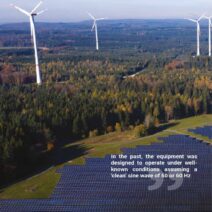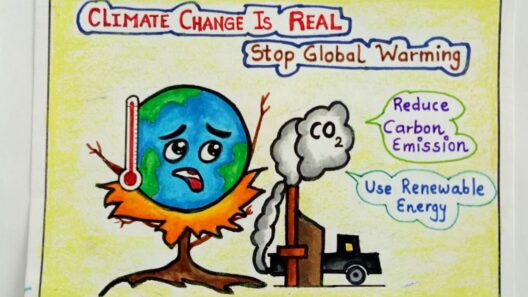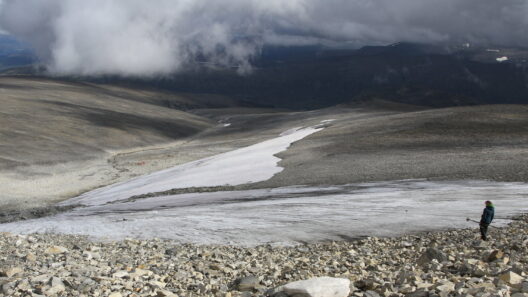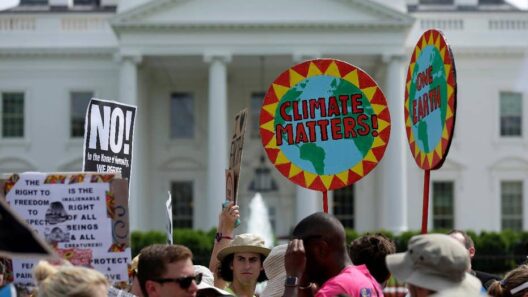El Niño is more than just a cyclical weather phenomenon; it is, at its core, a harbinger of change—a fiery embrace that envelops our planet and exacerbates the complexities of global warming. This climactic catalyst emerges from the warm currents of the Pacific Ocean, yet its impacts ripple across continents, shaping weather patterns, affecting ecosystems, and heralding societal challenges. Understanding El Niño is crucial in the broader discussion of climate change, as it epitomizes how natural patterns can interplay with anthropogenic factors, inflaming the already volatile condition of our planet.
At its essence, El Niño represents a warming of sea surface temperatures in the central and eastern tropical Pacific. This phenomenon disturbs the atmospheric equilibrium, creating a cascade of climatic effects worldwide. But why does this warming matter in the grander context of global climate disruption? The interconnection is profound. El Niño cycles occur every two to seven years, yet their repercussions reverberate far beyond their duration, occasionally accentuating the background warming trend induced by greenhouse gas emissions. This interplay serves as a poignant reminder of how climate systems are not isolated but intricately woven into a delicate tapestry of environmental interactions.
During an El Niño event, predictability becomes a casualty as weather patterns oscillate violently. The once-familiar rhythms of precipitation and temperature transform into erratic and tumultuous variations. Droughts scorch some regions, while others are inundated by floods. These extremes devastate agriculture, jeopardizing food security in vulnerable communities and amplifying existing inequalities. In nations heavily reliant on predictable seasonal weather, the fiery embrace of El Niño manifests not only as a climatic anomaly but also as an economic and humanitarian crisis.
Furthermore, the relationship between El Niño and global warming becomes increasingly alarming as the oceans warm. The cycle tends to intensify under higher global temperatures, fueling more extreme weather patterns and escalating the intensity of El Niño events themselves. Rising sea temperatures create a feedback loop; as the Pacific warms, it emits more heat into the atmosphere, increasing humidity and altering storm patterns. Each iteration of El Niño brings with it an unsettling uncertainty, a reality that underscores the urgent need for comprehensive climate action.
The impacts of El Niño are not confined to the margins of the Pacific. As it stirs the atmospheric pot, the effects can be felt as far away as the African Sahel, where rainfall patterns shift dramatically. The Sahel region is particularly susceptible to the shifts, often experiencing both drought and unusually heavy rainfall in different cycles. This volatility can decimate crops in one breath and induce flash floods in the next—an environmental dichotomy that leaves communities reeling. Displacement and conflict frequently arise from these disturbances, framing El Niño as not merely a climatic event, but as a catalyst for human suffering.
Moreover, the fiery embrace of El Niño extends to the oceans themselves, igniting a series of ecological challenges. Warmer sea temperatures can lead to coral bleaching events, as delicate marine ecosystems are pushed beyond their thermal thresholds. Such disturbances threaten not only biodiversity but also the livelihoods of millions who depend on these resources. The interconnectedness of terrestrial and marine ecosystems becomes starkly apparent, illustrating the far-reaching implications of even a single climate pattern.
In considering the future trajectories of El Niño and its relationship to climate change, one cannot ignore the underlying existential threats posed by rising global temperatures. If emissions continue unabated, the frequency, intensity, and duration of El Niño events may worsen, leading to even more catastrophic consequences. The fiery embrace of this phenomenon could morph into a conflagration, one that humanity may find increasingly difficult to extinguish.
Our understanding of these complex climatic patterns necessitates a reevaluation of our environmental policies and our collective approach to sustainability. As El Niño brings to the forefront the interconnectedness of our global climate system, a commitment to reducing greenhouse gas emissions becomes imperative. Transitioning to renewable energy sources, promoting sustainable agricultural practices, and enhancing climate resilience in vulnerable regions are pivotal steps. As the fiery embrace of El Niño unfolds, humanity stands at a crossroads, faced with a choice: to ignore the warnings of a warming planet or to embrace the challenge of climate action with vigor and resolve.
In conclusion, El Niño serves as a vivid metaphor for the urgent and burning need to address climate change. Its cycles of warmth are not merely natural occurrences; they encapsulate the vulnerabilities of our ecosystems and societies in an era of relentless global warming. As it intertwines with anthropogenic impacts, understanding and responding to El Niño becomes not just an academic endeavor but a moral imperative. The choices made today will decisively shape the contours of our climate future—a future that hangs in the balance, influenced by the fiery embrace of a natural phenomena that knows no boundaries.







